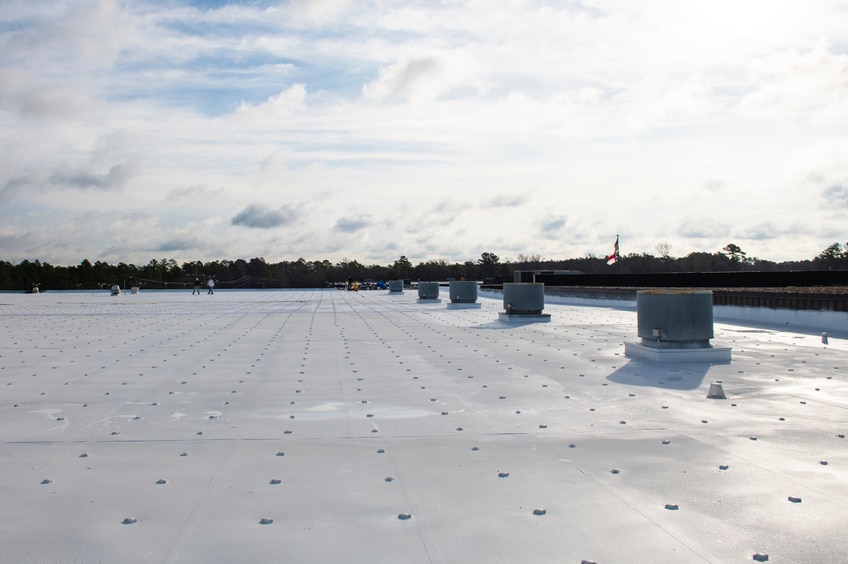Choosing the right roof coating can make a big difference in how effective and reliable your roofing system is. But how do you know what the right coating is for your roof?
The first step is to understand the basic features of each coating, and to match those features with the needs of your unique project. This article will explain the most common types of roof coatings and what factors to consider when searching for your perfect solution.
Understanding Roof Coatings
The uninitiated may think roof coatings belong in the same category as paint, but they're actually pretty different. The Roof Coatings Manufacturers Association explains that coatings have a higher solids content than paint and are formulated with high-quality resins that allow them to maintain their elasticity even as roofs expand and contract. They're also effective at protecting your roof from damaging elements like wind, rain, and UV exposure.
There are four main types of roof coatings:
- Elastomeric acrylic coatings are known for their durability and can be installed over a number of new or existing roof types, provided that the surface is properly prepared. These water-based coatings are available in highly reflective white colors that may lower the surface temperature of your roofing system.
- Silicone coatings are available in both high solid and low solid formulas. One of the biggest benefits of a silicone coating is that it typically does not contain a warranty exclusion for roof areas that pond water. As a result, silicone coatings may be a suitable option for properties located in wetter climates. Typical high-solid silicones may have the ability to be applied in a single coat, which has the added benefit of getting you off the roof quicker during the installation process.
- Fluoropolymer coatings deliver a high level of reflectivity and provide protection against weather elements and organic growths. They're highly flexible while still providing a tough, enamel-like finish that can resist dirt pickup. These characteristics are especially important for providing excellent UV and color stability.
- Urethane or polyurethane coatings provide an excellent balance of tensile strength, elongation, and hardness that protects against chemicals, mildew, and dirt pick-up. They are especially effective when used in applications requiring a tough finish that helps resist abrasion.
Many of these coating types can be installed on a variety of existing or new roof types. The type of roof being coated is an important consideration in choosing a suitable roof coating, but you'll also want to think about both functional and aesthetic considerations for the building.
Questions to Ask When Selecting Your Roof Coating
Each type of coating offers a number of benefits, so it can be difficult to determine which coating would be best for your project. You can get started on narrowing down the choices with a few basic questions:
What Are Your Goals?
Is your goal to extend the life of the existing roof, or perhaps to restore a leaking one? If the roof is still in good shape and doesn't have leaks, then a top coat can be used to help protect the existing roof against the damaging effects of weather and UV rays. If the roof is structurally sound but leaking, you may want to perform a restoration to repair the leaks and then install a complete multilayer roof coating system.
How Is the Building Used?
Before choosing a roof coating, it's important to understand what is happening inside the building. If it's a manufacturing plant, are chemicals being used? Is there food processing happening inside the building? If chemicals or grease from food processing will be an issue on the roof, a urethane coating might be a suitable choice because it provides protection against chemicals and grease. Note, however, that coatings manufacturers typically do not provide warranty coverage for exposure to grease or chemicals.
Maybe the building is a healthcare facility that requires low odor and little disruption to operations during the installation. In that case, you might select a low-odor, low-VOC acrylic elastomeric coating solution.
What Is the Building's Location?
If the building is in a humid area, a quick-drying, highly moisture-resistant silicone system would likely be a good fit. If it's going to be regularly exposed to hail, you might want to consider a fluoropolymer system that can provide superior impact resistance. Note, however, that coatings manufacturers typically do not provide warranty coverage for exposure to hail or other physical impacts.
Are there Aesthetic Considerations to Account For?
Every building has a style that should be complemented by its roof, especially if the roof is visible from the ground. While many roof coatings are white, there are a lot of color options to choose from when installing a coating system.
For more information, check out GAF's Liquid-Applied Coating Solutions.

